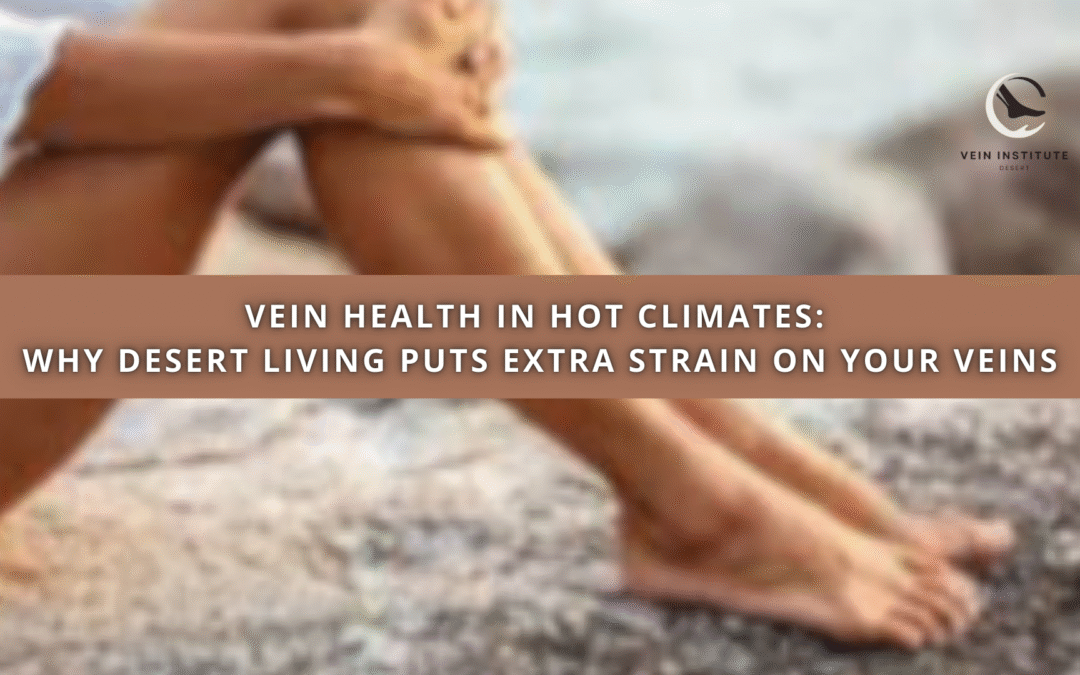How Extreme Heat Challenges Circulation
Living in the desert means constant exposure to high temperatures, sometimes reaching triple digits for months at a time. While people usually associate hot weather with dehydration or sunburn, fewer consider its impact on circulation and vein health. Heat naturally dilates blood vessels, making them wider. For individuals already predisposed to venous conditions, such as varicose veins or chronic venous insufficiency, this added dilation increases pressure in the leg veins.
This explains why people in regions like Palm Desert often notice heavier, swollen legs during the summer months. The body works harder to pump blood back to the heart against gravity, and heat makes this process even less efficient. Over time, the constant strain can contribute to visible varicose veins, spider veins, or persistent discomfort.
Why Desert Residents Should Consult a Vein Doctor
Residents of desert communities are at unique risk because their environment places a year-round burden on circulation. A vein doctor can evaluate whether heat is aggravating underlying conditions and provide preventive strategies before symptoms worsen. Ignoring the problem may lead to complications such as skin changes, ulceration, or chronic pain.
In Palm Desert, many patients visit The Vein Institute of the Desert after noticing seasonal flare-ups that don’t fully resolve when cooler weather arrives. This suggests that hot climates do more than create temporary discomfort—they accelerate existing vascular weaknesses. Early evaluation by a qualified vein specialist ensures tailored recommendations that may include hydration guidance, compression therapy, or advanced vein treatment if necessary.
The Role of a Vein Specialist in Desert Communities
A vein specialist does more than diagnose visible varicose veins. These professionals understand how environmental stressors like high heat, prolonged standing, or low humidity interact with vein health. For example, the dry climate common in the Coachella Valley leads to quicker dehydration, reducing blood volume and further taxing circulation.
Specialists can distinguish between temporary swelling from heat and more serious venous insufficiency that requires medical attention. At The Vein Institute of the Desert, patients receive individualized assessments that consider lifestyle, medical history, and the realities of desert living. This comprehensive approach is critical, since many desert residents are active retirees or seasonal visitors who want to maintain quality of life without being limited by leg pain or heaviness.
Lifestyle Factors That Increase Vein Strain in the Desert
Heat is only one piece of the puzzle. Daily routines in hot climates often compound venous stress. Many people avoid outdoor activity during the day, leading to prolonged sitting indoors. Sedentary habits reduce calf muscle pumping action, which is essential for blood return to the heart. Others work outdoors and endure hours of direct sun exposure, causing veins to swell and increasing fatigue in the legs.
Diet and hydration also matter. Insufficient water intake thickens the blood, making circulation more sluggish. High-salt diets, common with processed foods, can worsen swelling in already-dilated veins. When combined with desert heat, these lifestyle factors create a perfect storm for venous discomfort.
Advanced Vein Treatment Options in Palm Desert
Fortunately, modern medicine offers effective solutions that go beyond temporary relief. Advanced vein treatment options include minimally invasive procedures such as endovenous laser therapy, radiofrequency ablation, and sclerotherapy. These treatments target problematic veins directly, closing them off and rerouting blood through healthier pathways.
Patients at The Vein Institute of the Desert often appreciate that these treatments are performed in-office with little downtime. This makes them accessible even for those with busy schedules or seasonal visitors who need care during a short stay in Palm Desert. Importantly, treatment not only improves appearance but also alleviates discomfort and prevents future complications.
Why Choosing the Right Vein Clinic Matters
Not all medical providers specialize in veins, which is why selecting the right clinic makes a difference. The Vein Institute of the Desert in Palm Desert focuses exclusively on venous health. Their team combines advanced diagnostic tools with years of clinical expertise to ensure each patient receives the best possible outcome.
By addressing the unique challenges of desert living, the clinic helps residents and visitors alike protect their circulation in a demanding environment. Patients can expect more than symptom management—they receive long-term strategies for maintaining leg health in hot climates.
Living Comfortably in the Desert with Healthy Veins
Desert living offers beauty and lifestyle advantages, but it comes with medical considerations often overlooked. Heat, dehydration, and sedentary patterns all conspire to challenge vein health. Without proper attention, these factors accelerate conditions that may otherwise remain mild.
For those noticing discomfort, swelling, or visible vein changes, consulting a vein doctor in Palm Desert provides reassurance and proactive solutions. With expert guidance from The Vein Institute of the Desert, maintaining healthy veins is entirely possible—even under the unrelenting desert sun.

Andy Sharify
The founder and owner of The Vein Institute of the Desert. He oversees the clinic, ensuring exceptional service and a patient-focused approach to vein care. Andy is dedicated to creating a comfortable and supportive environment for every patient.
